


There’s far more to life than skateboarding. That statement probably won’t make me particularly popular among my fellow skateboarders, of course. But being a bit of a punker still, even well into my middle forties, I’m blessed by the curse of not giving too much of a shit about such trivialities. Life is far too short to allow yourself to be pigeonholed or packaged into an inhibiting personal prison. My job, as I see it, is to see, experience, dream, and grow. If that doesn’t suit your pet political penchants, well, so be it.
I have also been advised by a few of my mentors and confidantes that kids just can’t be bothered to read too much anymore. That’s too bad. If that’s true, then you’re probably gonna miss out on guys like Jules Verne, Jack London, Jack Kerouac, and Kurt Vonnegut. Not that they were “great” writers or anything, but still…
Thankfully, I did take some heed of this awful advice, and decided early on in the planning of this installment to tell my story much more in photographs, and a bit less in words. Some trips can’t be believably articulated, anyway; some things just have to be seen to be trusted. I had a hunch that this Quartzsite expedition might just be one of those extraordinarily eventful excursions. Turns out, I was right. And thankfully so.
My road map for this trip was guided by a neat and novel new website that I had stumbled upon, quite by accident, called Roadside America (www.roadsideamerica.com). Inside that web world, you’ll find a full and complete cataloging of every obscure American oddity that the average would-be road adventurer might find fun and fascinating. As it turns out, Roadside America is pretty spot-on, and a great resource for the geekery that defines me.
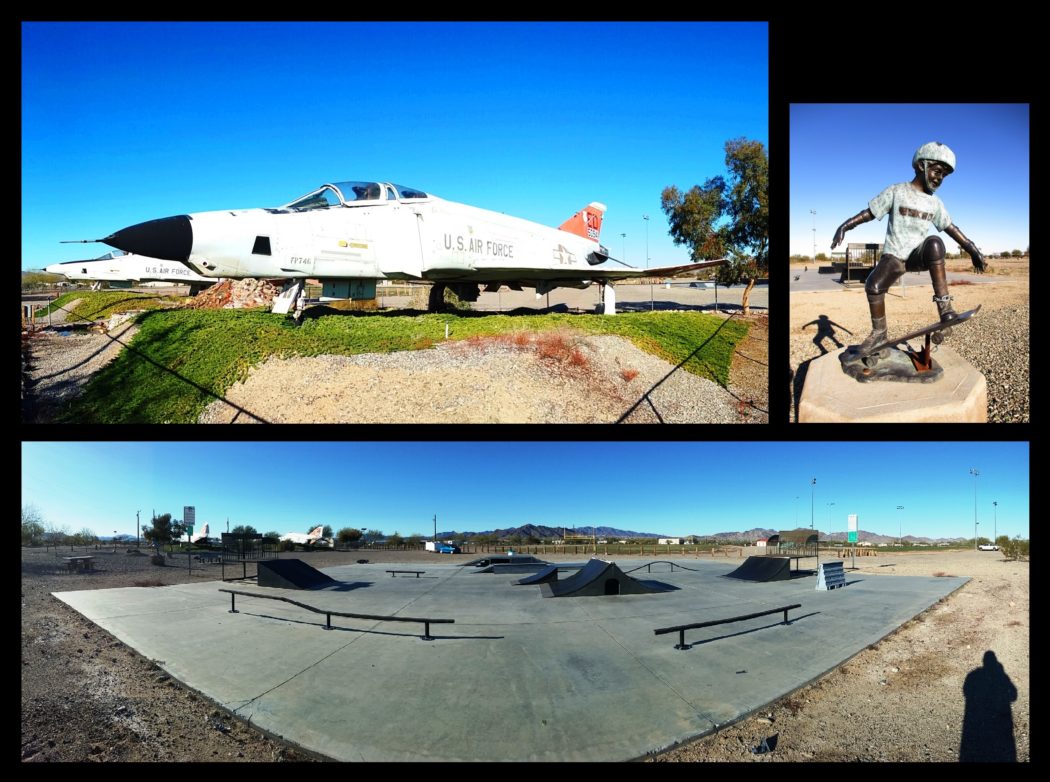
Clockwise from top left: McDonnell Douglas NRF-4C Phantoms at Freedom Park; the bronzed waste of time and money; the Quartzsite Skatepark. Quartzsite, Arizona.
My very first stop in Quartzsite was at a public garden called Freedom Park, where I found two aging examples of one of my all-time favorite airplanes, the McDonnell Douglas F-4 Phantom II. Or in this case, more specifically, NRF-4C Phantoms. These particular planes served with overseas tactical reconnaissance squadrons before landing at the AFFTC (Air Force Flight Test Center) at Edwards Air Force Base, where they were used to for on going flight test support; the “ED” tail codes and 6510 Test Wing emblems on the fuselages gave their whole story away to the discriminating dork in me. Whatever else I wanted to find out about these Phabulous Phantoms… which was pretty much, “everything”… I could hastily and efficiently retrieve by simply Googling their serial numbers, a fun little trick that I’ve been employing pretty regularly these days. The ‘Net, after all, is an absolutely amazing resource for certifiable nerds like me. Everything is there, just waiting to be discovered.
“Prefab plastic swill. If you do make a pit stop here, just take a funny pic with the goofy skate statue in front of the park and leave. More fun to be had at the various junk shops and flea market booths around.”
– Concrete Disciples review of the Quartzsite Skatepark
I was advised well beforehand that the Quartzsite skatepark was going to suck. It really lived up to my lowly expectations. It seems like they might have spent more on the bronze statue dedication to the skatepark, than they might have spent on the skatepark itself. And look at that skateboard; it looks more like a small snowboard mounted up with clay wheels and Chicago trucks, than an actual skateboard. The fact that the kid is tethered to the pedestal is freakishly ominous; this Skatewave skate-place does seem like a jail of sorts, where kids are sentenced to suckiness for the rest of their lives until they either quit skateboarding, or move to The Big City… whichever comes first. I did manage to get my must-do trick here though, the obligatory frontside rock; when you’ve skated as many sucky Skatewave parks as I have in the last ten years (or so), you do start getting used to them. It still wasn’t particularly easy to pull off, though. The only thing worse than the crappy obstacles is the overall setup of the place; here, the skate obstacles themselves become ironic obstacles to enjoyable skateboarding.
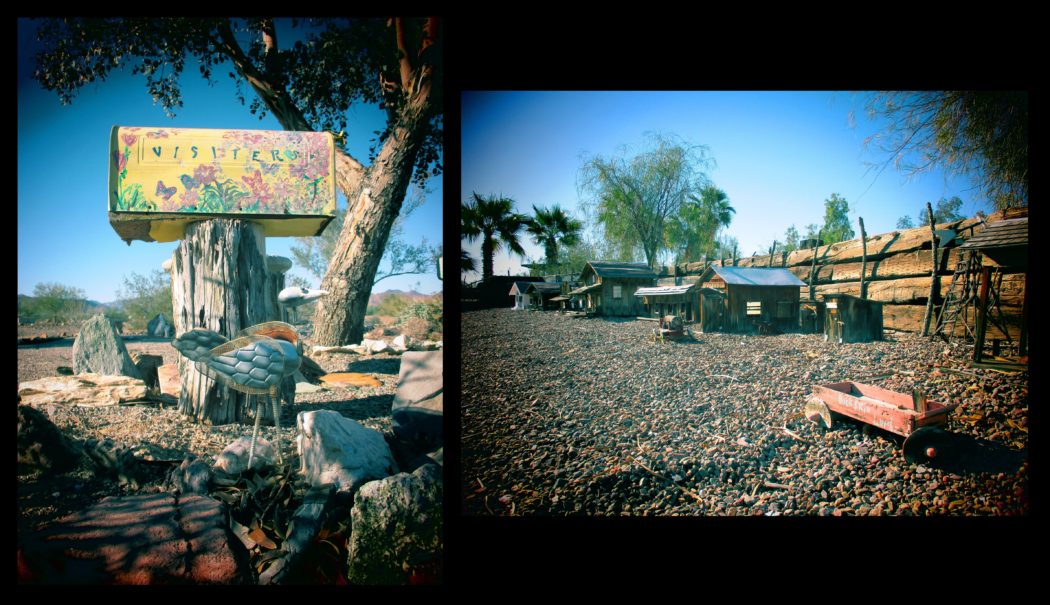
Left and right: Celia’s Rainbow Garden, Quartzsite, Arizona.
Celia’s Rainbow Garden was right around the corner from the skatepark. It’s a botanical monument to a local girl that died (at 8 years old) of a rare viral heart infection. The story is heart-wrenching, of course; only a true megalomaniac could avoid being somehow affected by such a tale. But the garden is a study in strikingly solemn beauty, a truly creative and collaborative community effort. It is currently the largest (if not the only) free botanical garden in the state, and it provided me ample opportunities to shoot colorfully saturated photos of extraordinary objects from strange and unusual perspectives.
Roadside America had enlightened me to the existence of Naked Paul at Reader’s Oasis Books on Main Street in Quartzsite. Naked Paul is the owner of the place, and apparently mans his humble bookshop sans clothing. This, I just had to see for myself; I can bring myself to believe a whole lotta horsecrap, but this was just too over the top for my temperamental tastes. Turns out, the tales are totally true… Naked Paul has pictures all over the place of himself being naked, typically with a tourist within an arm’s embrace… but unfortunately, they’re also totally seasonal, and not particularly applicable to the frigid frost of the desert winter. I did manage to shoot a few photos off their offbeat literary offerings, and I made a small donation to Celia’s Garden while I was there with the little bit of cash I was carrying. It was the very least I could do, I thought.
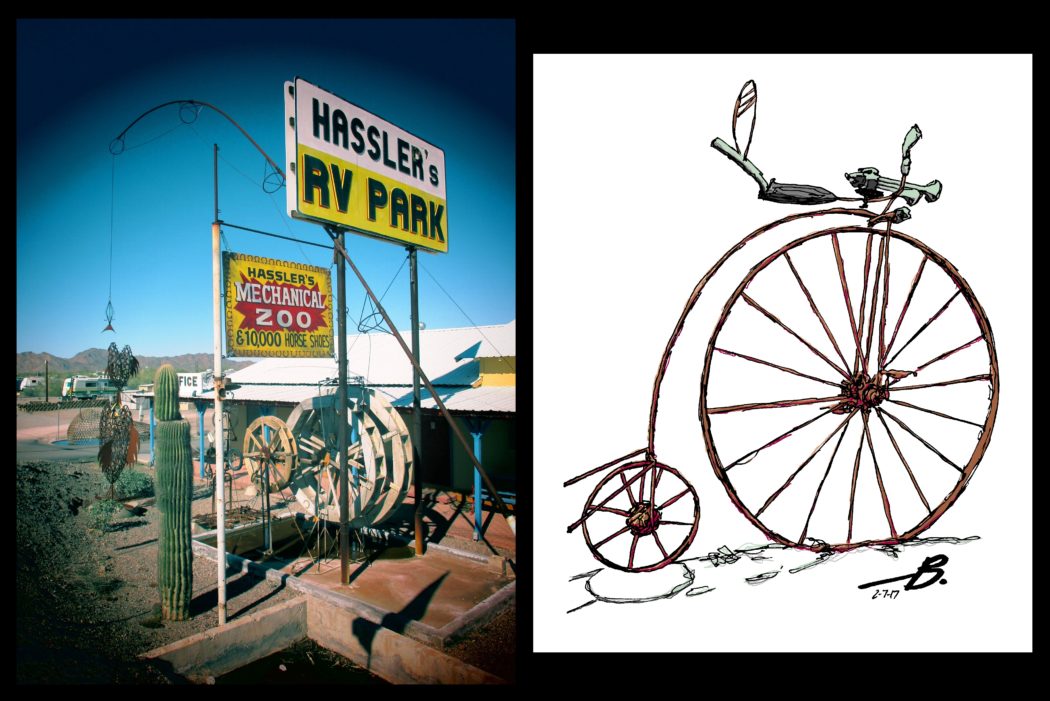
Left: Hassler’s RV Park, Quartzsite, Arizona. Right: steel sculpture at Hassler’s RV Park, illustration by the author.
Yes, “RV Park Sculptures” are a very real thing in this topsy-turvy world of roadside bemusements. Hassler’s RV Park is a cornucopia of steel structures of the clever and funny variety. Bicycles, bobcats, whales, and bears were all forged from horseshoes and castaway rebar, among other steel tidbits; ah, the clever things we can craft from castaways. After Celia’s Rainbow Garden, I kind of needed a chuckle. Hassler’s didn’t disappoint.
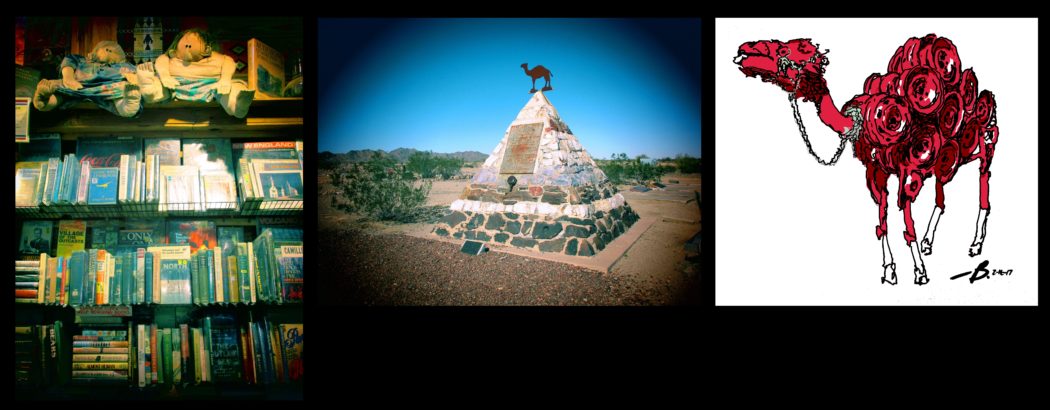
Left: Reader’s Oasis Books; sorry, no Naked Paul today. Center: Hi Jolly Monument. Right: wheel rim camel sculpture, illustration by the author.
Hadji Ali… popularly and affectionately known as “Hi Jolly”… was a Syrian camel driver that was recruited by the United States Army to lead an obscure (and ill-advised) 1856 experiment involving testing camels as pack animals in the arid desert southwest. An American legend… at least, in this far corner of the country… he is memorialized by a pyramid-shaped tomb near downtown Quartzsite. The camel experiment having roundly failed (as far as the U S Government was concerned, at least), the animals were released to the wild, with the last camel sighting occurring as late as 1942. Ironically, I visited this memorial on the very same day that Donald Trump was signing an executive order banning Syrian immigrants from our shores. Hi Jolly might well have been rolling over in his tomb, just as I was standing squarely upon it. The world works in really strange ways, sometimes.
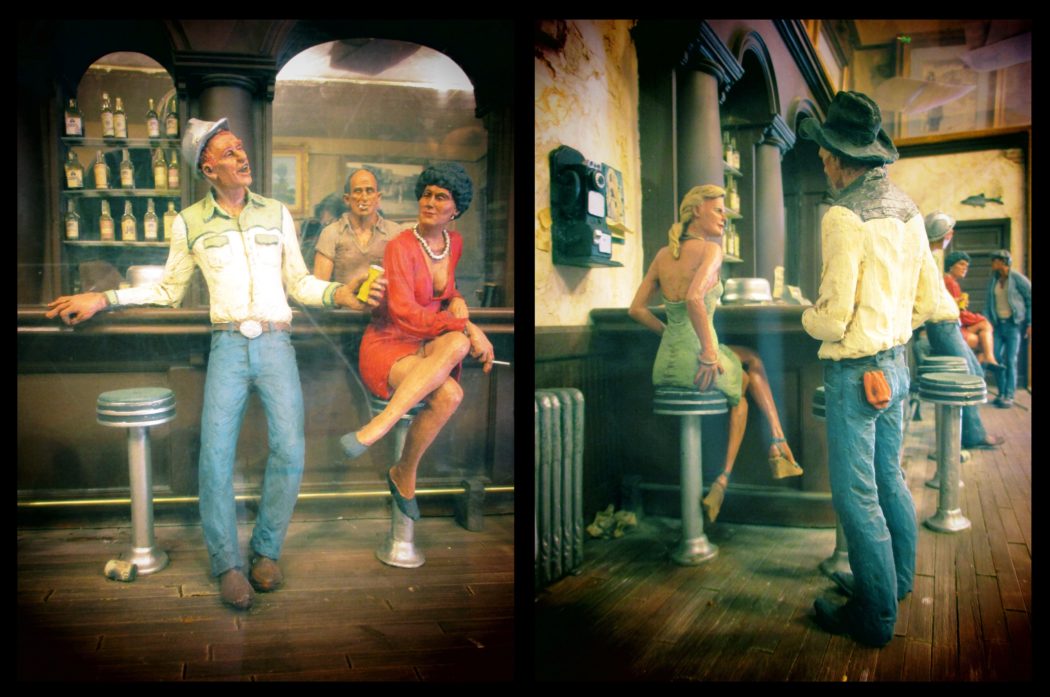
Left and right: two views of the Tyson’s Well Stage Museum diorama, Quartzsite, Arizona.
Tyson’s Well Stage Station Museum is a former stagecoach stop that currently houses mining artifacts, homesteading displays… and this really strange, display-case-sized diorama of a “typical” 1950s bar scene, complete with miniature bottles of booze, a pint-size cigarette vending machine, and a whole host of creepily entertaining characters socializing on and around the barstools. It seemed extraordinarily out of place in a museum setting. At the same time, it was probably one of the most entertaining exhibits I’ve ever seen.
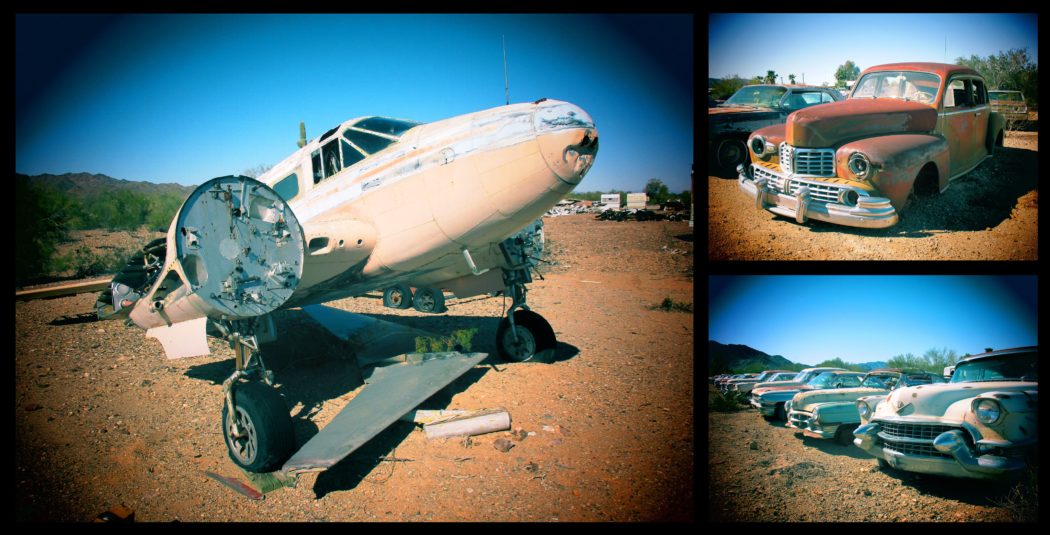
Relics rusting away in the desert at the Quartzsite Airport, Quartzsite, Arizona.
Next on my visit-list was The World’sLargest Belt Buckle (it really is pretty big), the “Wheel Rim Camel” (a camel sculpture made out of… yes, you guessed it… wheel rims)… and then, we stopped at the Quartzsite Airport. Which, like most things in Quaztzsite, is not entirely what it was advertised to be. Thinking that it’s a functioning facility with flyable hardware, we actually discovered a strange and decrepit boneyard of archival aircraft components, and a field full of reasonably well-preserved vintage Cadillacs, patiently awaiting some sort of vague and uncertain fate. We liked the area so much that we made it our evening’s campsite, where we got to watch a fireworks display erupting over our camper while we listened to the succulent sounds of a ragtime Christian revival emanating from a nearby yurt. Quartzsite was certainly full of strange surprises. We learned that much the fun way on Saturday.
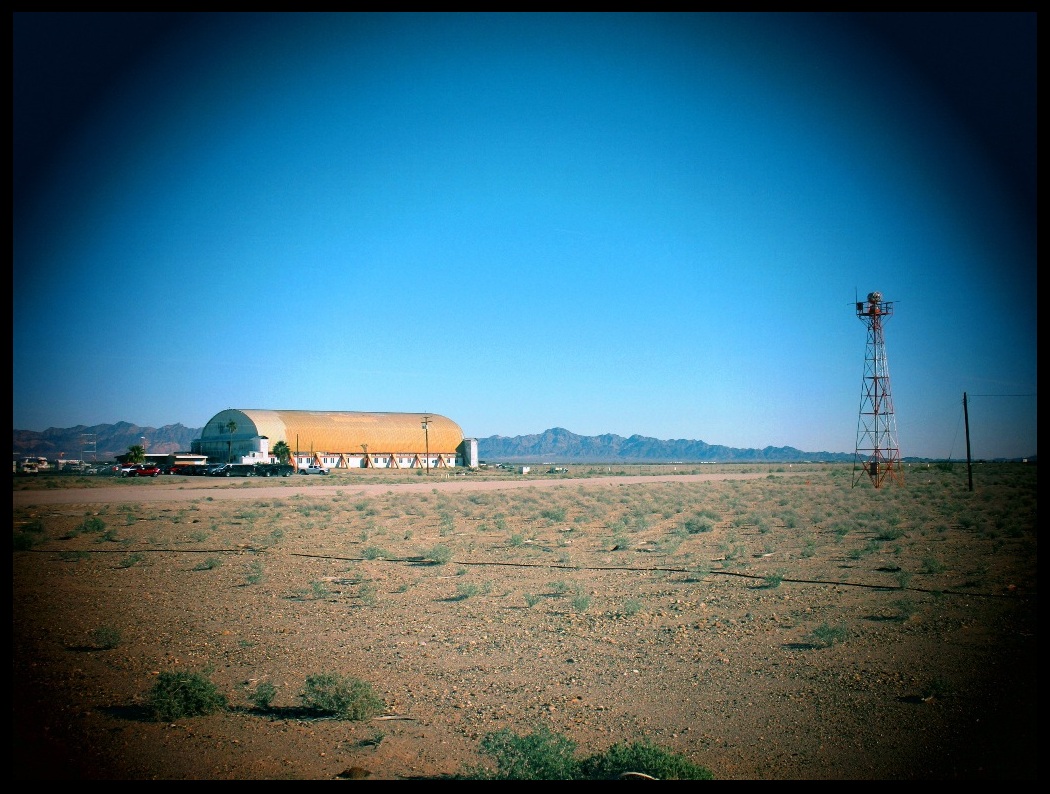
The less-abandoned Blythe Airport, where clandestine military maneuverings still happen to this very day. Blythe, California.
The Southwest is still largely defined by World War II, and the immediate aftermath of the immense war effort. Relics of the mighty military effort still liberally litter the desertscape, close to seventy years after the fact. Blythe, California, hosts not just one, but two abandoned WWII airfields… although this one was “abandoned” only in the semantic sense. In reality, I found a horde of anonymously-dressed “civilians” and blacked-out SUVs cavorting here, along with some impressively foreign military hardware that seemed strictly engaged in some sort of super-secretive maneuvers. I swore my secrecy of the finer details (and the resultant classified photos) in exchange for some suave intelligence on a far more accessible abandoned airfield just across town. Secure in some British officers’ enthusiastic permissiveness, I thus made my way to what would become the score of the day.
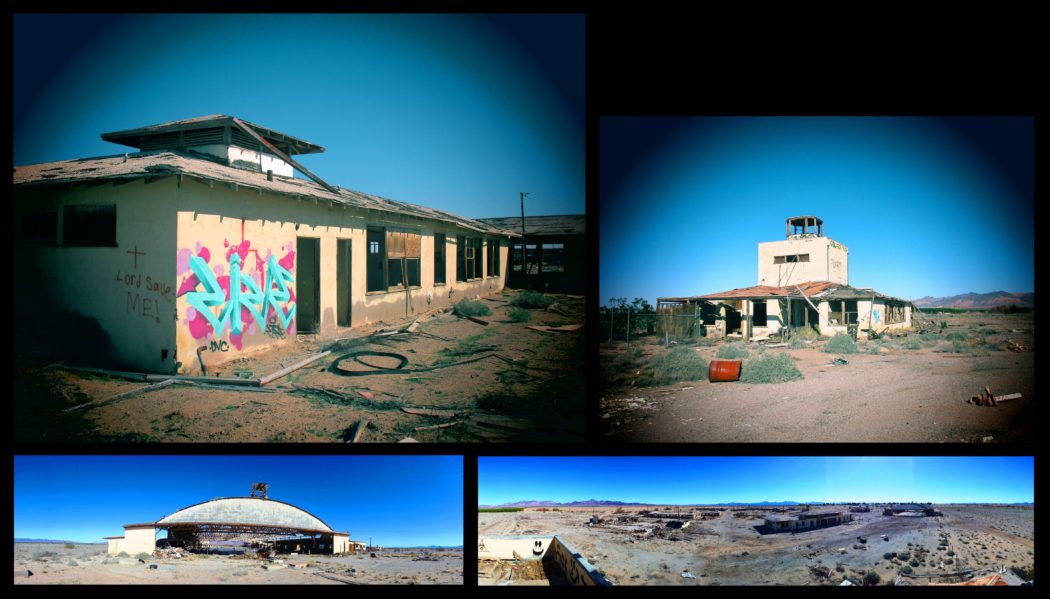
Clockwise from upper left: abandoned barracks at Gary Field; the old control tower; panoramic view of the abandonment from the top of the control tower; the remains of the last standing hangar at Gary Field. Blythe, California.
Blythe Field was subsequently known in it’s WWII heydays as Gary Field. It was the home base for the Morton Air Academy, a contract aviation school that churned out trained flying cadets for the United States Army Air Forces. Today, it remains (barely) standing as an atlas obscurity known as W. R. Byron Airport, named after its apparently absentee owner. Having recieved surprise permission to do a little bit of urban exploration, I carefully strolled the grounds, climbed the control tower… a heart-stopping exercize in immediate risk, that was… sifted through debris, and photographed the site to my heart’s never-ending content. Yes, it was extremely hazardous hunting… and yes, it was eerie and creepy as hell… but this sort of history simply cannot be experienced (or appreciated) secondhand. It takes getting upclose and personal with the ghosts of these places to truly understand, internalize, and empathize with the significance of the homefront war effort, and the mass dismantling and abandonment that followed.
An hour’s drive away in Poston, Arizona was a memorialized reminder of a far different sort of struggle on the WWII homefront. Namely, the struggle for Americans to retain their rights in a fearful and insecure world. After Pearl Harbor and the sweeping victories of the Emporors Empire all across the Pacific, of course, anti-Japanese sentiment ran amok; Americans (of Japanese descent) were roundly and arbitarily suspected of anti-American espionage and terrorism, rounded up, stripped of their worldly possessions and property, and trucked away to inhospitable desert internement camps… much against their free will, of course… for the balance of the war. Ironically, these camps were sited on the sovereign lands of another historically oppressed American minority, the reservations of the Colorado River Indian Tribes; turns out, the Indians weren’t exactly happy about this forced Jap invasion at the hands of the Presidents’ Executive Orders. Poston was the largest of these internment concentration camps, and this memorial represents their dignified struggles to retain their “constitutionally guaranteed” rights and liberties in the face of widespread public propaganda and misguided racial hatred. Not unlike the sort of politically directed disservice that we’re subjecting the Muslims to, today.\
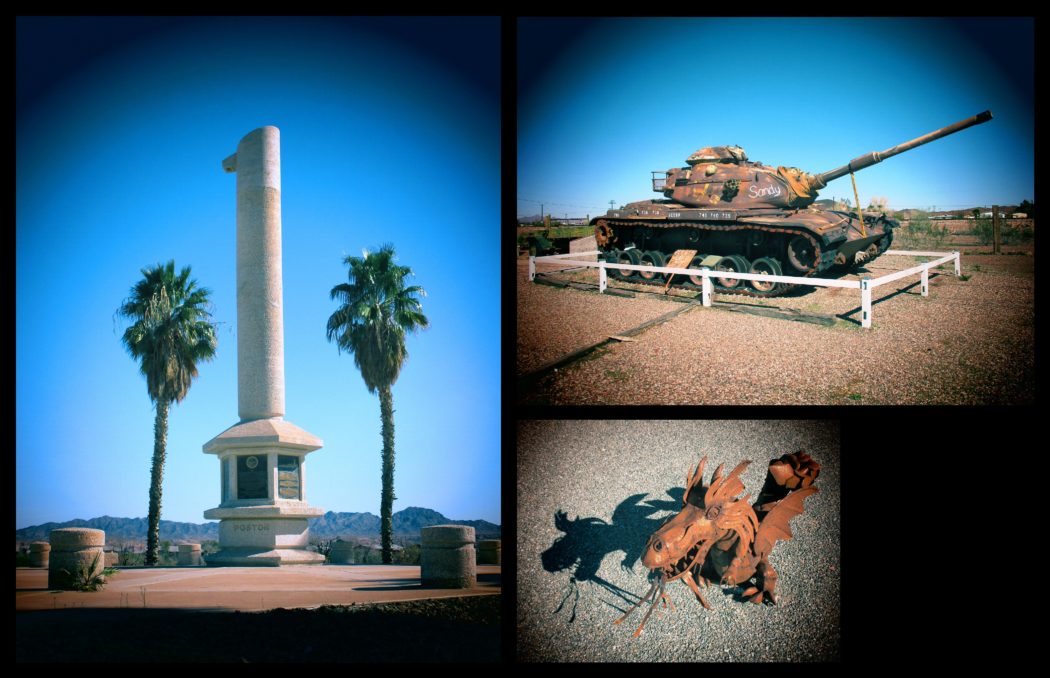
Clockwise from left: Japanese internment camp memorial, Poston, Arizona; battle tank memorial to General George S. Patton, Bouse, Arizona; steel sculpture, Salome, Arizona.
Before George S. Patton became a celebrated national hero, he was the commanding officer of the sprawling Desert Training Center (DTC), later more widely known as the California-Arizona Maneuver Area (CAMA). A massive desert warfare simulation site of epic proportions, the DTC covered virtually all of Southern California and western Arizona (except for the aforementioned Japanese internment camps, which were probably located right in the middle of the battle zone to keep The Japs both figuratively, and literally, in their damned place); it ended up being the largest military training ground in the history of military maneuvers (according to Wikipedia). The CAMA eventually covered an area approximately 350 miles wide by 250 miles long, and included eleven camps, five major airfields, five minor airfields, and dozens of auxiliary [emergency] airfields. This Patton tank in Bouse, Arizona, is a way-off-the-beaten-path remembrance of Patton’s single-minded military mission; rumour has it that he even slept on the floor of the A & C Mercantile across the road when he flew into town.
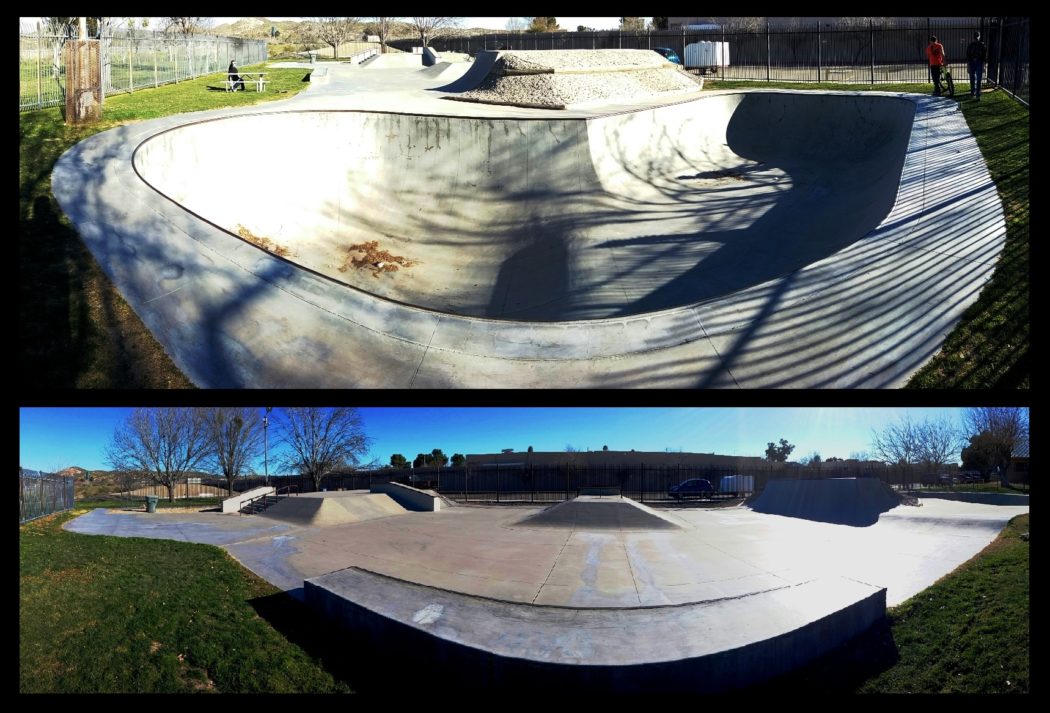
Top and bottom: Wickenburg Skatepark, Wickenburg, Arizona.
The western-themed town of Wickenburg was my last stop of the weekend as I made my way back home. Far better than the skatepark of suckiness that I experienced in Quartzsite, this was a concrete mini-marvel of a skatepark, anchored by a midsized bowl that was almost perfect, if only it wasn’t filled to the brim with litter and leaves. Apparently it doesn’t get used all that much by the locals, and they obviously can’t be bothered with sweeping it out from time to time. But just like the rest of the stops on my weekend tour, it was still pleasantly entertaining in its own weird, eccentric sort of way.
I just got back two days ago. The camper is already restocked, and the gas tank is full again. I’ve got some money burning a hole in my pocket. I wonder where I’ll go from here.

